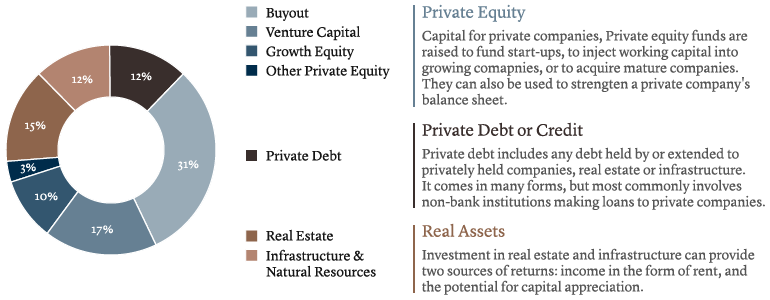private assets.
For eligible clients, we see many reasons to include private assets as part of a well-diversified, long-term investment strategy.

why invest in private assets?
For investors who can place capital for the long run and tolerate illiquidity, diversified exposure to a range of private assets, together with a consistent multi-year strategy, can improve a portfolio’s overall returns.
The benefits of investments across a range of private assets can include enhanced returns versus public markets, lower volatility given lower exposure to short-term market movements, and greater portfolio diversification.
Private capital remains less than 5% of global financial markets1, implying significant scope for expansion. This is reflected in our own, forward-looking 10-year return expectations.

Enhanced returns
Academic research suggests top-quartile private equity has historically outperformed public markets2. This is reflected in our own, forward-looking 10-year return expectations.
Since private assets must often be held over multiple years, and can be difficult to sell, investors can earn an ‘illiquidity premium’ which compensates them for locking up their money over extended periods. The asset class can therefore serve as a useful performance enhancer in a traditional portfolio.
Lower volatility
Because private assets are not traded on public markets, there is limited exposure to short term volatility caused by market movements.
The impact of market corrections can also be lower for private assets. The S&P 500 fell around 52% from peak to trough during the global financial crisis of 2007-2008, while private equity fund of funds lost just under half that value, notes Cambridge Associates.
Exposure to private companies
Investing in private assets is the only way to access the opportunities offered by private companies, giving investors access to parts of the economy that cannot otherwise be reached.
Investing only in listed assets misses out vast swathes of value created in the economy. An estimated 86% of firms in developed economies with more than USD 250 million of revenues are privately owned .
The number of US public companies has also declined sharply over the last 30 years. Integrating private assets into a multi-asset portfolio can thus offer a different and potentially complementary set of opportunities.
Early-stage, privately owned firms also tend to be the ones trialling new ideas and technologies. Investors not exposed to private companies could therefore be foregoing promising new areas of innovation and long-term economic growth drivers, particularly in the field of sustainability.
a multi-year investment strategy.
We favour a multi-year investment strategy, across private asset classes, for potentially enhanced returns, lower volatility, and portfolio diversification.
We believe a disciplined, selective, and gradual approach is paramount. Adequate diversification is also key, to benefit from the different characteristics of the sub asset-classes throughout the economic cycle, and as the market for a wider range of strategies deepens.
Consistent deployment of capital over time spreads risk and avoids the possibility of missing out on returns from any particularly strong year.
choosing the right managers is critical.
Since private markets are less efficient than public ones, choosing the right fund managers is critical: the difference between strongly and poorly performing private equity funds tends to be more marked than in other asset classes.
The ability to choose and access investment vehicles from the top managers is a critical element of successful investing in private markets.
That is why, in addition to our own investment offering, our dedicated and experienced team build long-lasting relationships with managers across the industry. They also perform in-depth due diligence on investment vehicles, to give our clients access to the most compelling opportunities in the market.
investment risks.
Private assets are not appropriate for every investor due to their long-term and illiquid nature. Investments can last over 10 years, during which time investors’ capital can be locked in.
In general, private assets are not publicly traded or freely exchangeable. It may be difficult to assess a proper market price for such investments, to generate liquidity at a reasonable price, or, in some circumstances, at any price.
Private assets should therefore be regarded as a long-term investment, and not appropriate for investors who plan to withdraw their money during the life of the investment.
Past performance is not indicative nor a guarantee of future returns, and such investments also incur the risk of capital loss.
1 Source: Securities Industry and Financial Markets Association, Bank of International Settlements (BIS), Pitchbook, Apollo. As of 2022 and Q2 2023 – Bank of International Settlements data
2 Private Equity Performance: What do we know? Harris, Jenkinson, Kaplan
3 Source: Capital IQ, August 2023. Statistic refers to the share of private and public companies in the United States, Europe and Asia with last 12 months’ revenues greater than USD 250 million





share.